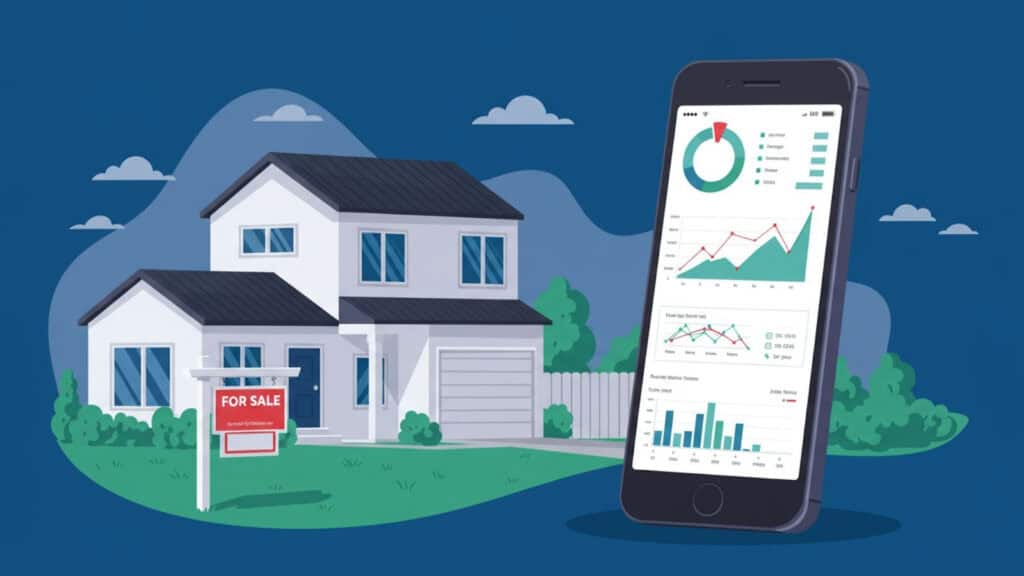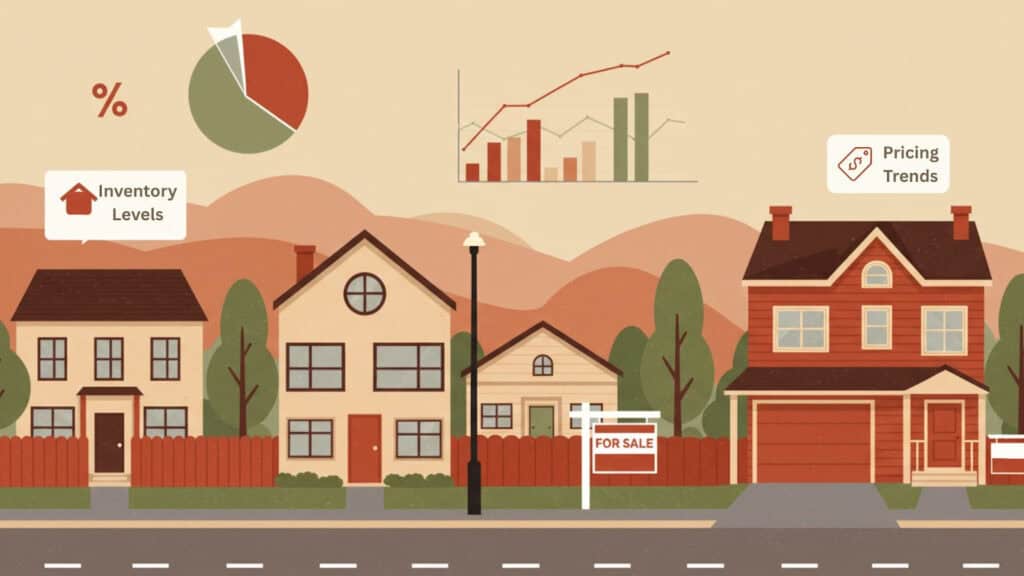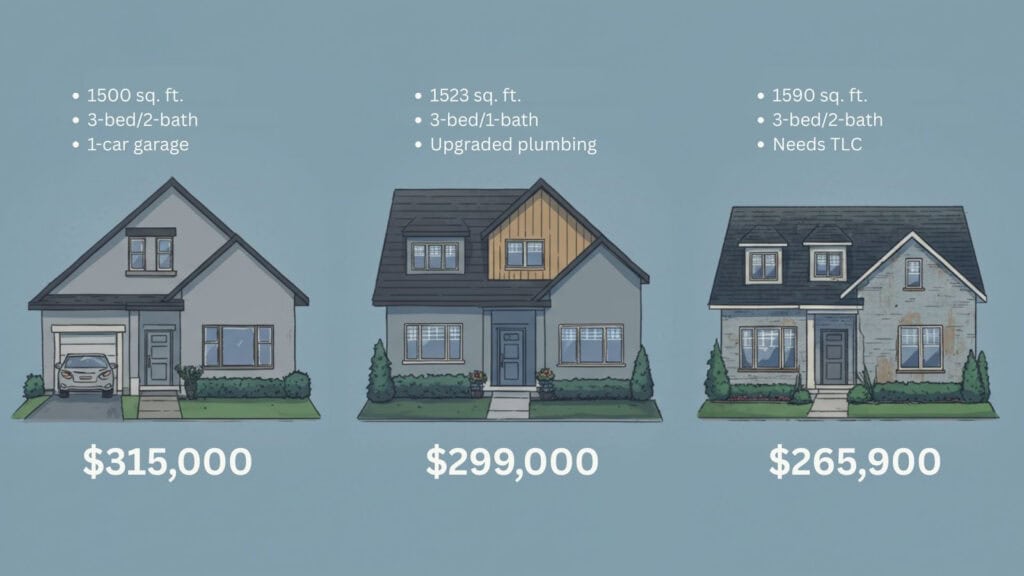
How to Price Your Home: Key Factors That Determine Market Value
Strategic home pricing reduces market time and attracts more qualified buyers through competitive positioning.
- Comparable property analysis forms the foundation of accurate valuation using recent sales data from similar homes
- Current market conditions in 2025 show rising inventory but continued pricing pressure from elevated interest rates
- Location dynamics and property condition directly impact buyer perception and willingness to pay premium prices
- Seasonal timing and flexibility allow you to optimize market positioning and respond to buyer feedback
Set your price using recent sales data, consider seasonal timing, and stay flexible based on market feedback to maximize your sale success.
Setting the right price when you’re ready to sell your home is one of the most important decisions in the entire selling process. The current real estate market presents unique challenges and opportunities that directly impact how to price your home effectively. With inventory levels rising 7.2% year-over-year and median home prices reaching $443,471 nationally, today’s sellers need a strategic approach that balances market realities with profit maximization.
Homes are taking an average of 43 days to sell, with 29% of properties still selling above list price despite shifting market conditions. However, 22.1% of listings now include price reductions. These statistics highlight the importance of pricing your home correctly from the start.
Understanding current market dynamics becomes even more vital when you consider that 82% of homeowners remain locked into mortgage rates below 6%, creating a unique supply constraint that continues to influence pricing decisions across most markets.
Why Does Your Home Pricing Strategy Matter?
Your home pricing strategy impacts every aspect of your selling experience, from the quality of buyers you attract to the final amount you walk away with at closing. Well-priced homes generate more showing activity, receive multiple offers more frequently, and typically sell closer to their asking price.
Strategic pricing taps into buyer psychology and market mechanics that work in your favor. Homes priced appropriately within their market range appear in more online searches, attract purchasers who can afford the payment, and create urgency that often leads to faster sales.
Conversely, overpricing your home can result in extended market time, fewer showings, and eventual price reductions that signal distress to potential buyers. Properties that linger on the market often sell for less than they would have if priced correctly from the beginning.
The financial impact of pricing decisions extends beyond the sale price itself. Carrying costs, opportunity costs, and negotiating position all improve when you implement an effective home pricing strategy that aligns with current market conditions.
What Should You Know About the 2025 Real Estate Market Climate?
The 2025 housing market presents a complex environment that requires careful analysis for successful pricing decisions. Current conditions show a market in transition, with several key factors influencing how to price your home effectively.
Interest rates remain elevated compared to recent years, with 30-year fixed rates averaging 6.7% as of July 2025. This environment has created a “lock-in effect” where existing homeowners with lower rates are hesitant to sell, contributing to ongoing inventory constraints in many markets.
Home price appreciation has moderated from previous years, with year-over-year growth slowing to just 1.2% nationally. This deceleration reflects changing market dynamics where buyers have become more selective and price-sensitive.

Regional variations play an increasingly important role in pricing decisions. Markets with high inventory levels, particularly in the Southwest and parts of Florida, are experiencing price corrections, while Northeast and Midwest regions maintain more pricing stability due to supply constraints.
The current buyer profile also influences pricing strategy. With affordability challenges affecting many potential purchasers, homes priced competitively within their market segment are more likely to attract qualified buyers who can secure financing and complete transactions.
How to Price Your Home and Master Comparable Property Pricing
Comparable property pricing forms the foundation of accurate home valuation and is the most reliable method for determining your home’s market value. This analytical process involves examining recent sales of similar properties in your area to establish a pricing baseline that reflects current market conditions.
Start your comparable analysis by identifying properties that sold within the last three to six months in your immediate neighborhood. Focus on homes with similar square footage, bedroom and bathroom counts, lot sizes, and architectural styles. The most relevant comparables typically fall within a quarter-mile radius of your property and share similar characteristics that buyers would consider when making purchasing decisions.
Pay close attention to the condition and upgrade levels of comparable properties. A recently renovated home with modern finishes will command a premium over properties requiring updates, even if the basic structure remains similar. Document these differences and adjust your pricing expectations accordingly.
Consider the marketing time and final sale prices of your comparables. Properties that sold quickly often indicate pricing below market value, while homes that took longer to sell might suggest initial overpricing or unique challenges that affected marketability.

Here’s a practical framework for evaluating pricing factors:
| Pricing Factor | Impact Range | Example Adjustment |
| Superior Location (waterfront, cul-de-sac) | +5% to +15% | $15,000 to $45,000 on $300K home |
| Recent Updates (kitchen, baths) | +3% to +10% | $9,000 to $30,000 on $300K home |
| Poor Condition (deferred maintenance) | -5% to -20% | -$15,000 to -$60,000 on $300K home |
| Busy Street/Undesirable Features | -3% to -10% | -$9,000 to -$30,000 on $300K home |
| Seasonal Timing (spring vs. winter) | +2% to -5% | $6,000 to -$15,000 on $300K home |
What Are the Essential Factors That Impact Home Pricing for Sale?
Several key factors directly influence your home’s market value and pricing strategy. Understanding how each element affects buyer perception and willingness to pay helps you set a competitive price that attracts serious offers while maximizing your return.
How Do Location and Neighborhood Dynamics Affect Pricing?
Location remains the primary driver of home values, influencing both current pricing and future appreciation potential. Properties in desirable school districts, walkable neighborhoods, or areas with strong job markets typically command premium pricing compared to similar homes in less sought-after locations.
Proximity to amenities like shopping, dining, parks, and transportation hubs directly affects pricing decisions. Homes within walking distance of popular destinations or with easy highway access often justify higher asking prices, particularly in markets where convenience ranks as a top buyer priority.
Consider your neighborhood’s trajectory and development plans that might impact future values. Areas experiencing revitalization, new commercial development, or infrastructure improvements often support more aggressive pricing strategies, while neighborhoods facing challenges might require more conservative approaches.
How Do Property Condition and Strategic Upgrades Impact Price?
Your home’s condition influences how to price your home competitively. Properties requiring immediate repairs or updates typically sell for less than move-in-ready alternatives, even when the underlying structure and location remain comparable.
Focus on improvements that provide strong returns on investment when setting your price. Kitchen and bathroom updates, fresh paint, new flooring, and enhanced curb appeal often justify higher asking prices and attract more buyer interest.
However, avoid over-improving for your neighborhood or making highly personalized modifications that might not appeal to broader buyer segments. Create a property that feels current and well-maintained while staying within reasonable price ranges for your market area. Consider focusing on cost-effective improvements that provide the best return on investment.
How Do Market Timing and Seasonal Considerations Influence Pricing?
Timing your listing launch can impact both your home pricing for sale and transaction speed. Spring typically represents the strongest selling season, with increased buyer activity and families planning relocations around school schedules.
Summer markets often maintain good momentum, though vacation schedules might slow activity during peak travel months. Fall can provide opportunities for motivated buyers who need to relocate before year-end, while winter markets typically favor buyers due to reduced inventory and less competition.
Current market conditions in your specific area should guide timing decisions more than general seasonal patterns. Areas with strong job markets or unique attractions might maintain consistent buyer activity throughout the year, while others show more pronounced seasonal variations.
How Do Size, Features, and Unique Selling Points Affect Value?
Property size, layout efficiency, and special features all contribute to pricing decisions. Square footage provides a baseline for comparison, while functional layouts, storage space, and flexible room usage can justify premium pricing in competitive markets.
Unique features like pools, fireplaces, high-end appliances, or outdoor entertainment spaces may add value depending on local buyer preferences. However, highly specialized features might limit your buyer pool and require careful pricing consideration to avoid overvaluing these elements.
Energy efficiency features, smart home technology, and modern systems increasingly influence buyer decisions and pricing. Properties with solar panels, updated HVAC systems, or comprehensive home automation often command higher prices while reducing ongoing ownership costs for buyers.
What Are the Most Common Home Pricing Mistakes That Cost Sellers?
Even experienced homeowners can make costly pricing errors that impact their selling success. Understanding these common mistakes helps you develop a more effective approach to pricing your property.
Pricing Based on Personal Investment Rather Than Market Value is a frequent error sellers make. Your renovation costs, original purchase price, or sentimental attachment don’t determine current market value. Buyers focus on comparable sales and current conditions, not your financial history with the property.
Using Outdated or Inappropriate Comparables can lead to pricing miscalculations. Relying on sales from six months ago, properties in different neighborhoods, or homes with substantially different features provides misleading guidance for current pricing decisions.
Ignoring Current Market Conditions when learning how to price your home often results in overpricing that extends market time and reduces final sale proceeds. Markets shift quickly, and pricing strategies that worked during seller’s markets may prove ineffective when conditions favor buyers.
Setting Prices Above Search Thresholds can eliminate large portions of your potential buyer pool. Many buyers set maximum search parameters in round numbers, so pricing your home at $305,000 instead of $299,900 might exclude everyone searching under $300,000.
Refusing to Adjust Based on Market Feedback when initial pricing proves too aggressive compounds the original error. Properties that sit on the market develop stigma, and eventual price reductions often need to be more substantial to regain buyer interest.
Emotional Decision-Making, rather than data-driven analysis, frequently leads to unrealistic pricing expectations. Successful sellers separate their emotional connection to the property from business decisions about pricing and marketing.
What Professional Tools Provide Accurate Home Valuation?
Modern tech solutions provide sophisticated tools for determining accurate home values, though understanding their limitations remains equally important. Automated valuation models (AVMs) used by websites like Zillow, Redfin, and Realtor.com process vast amounts of data to estimate property values, but these tools work best as starting points rather than definitive pricing guides.
Professional appraisals provide the most comprehensive valuation analysis, considering property condition, local market nuances, and recent comparable sales that automated systems might miss. While appraisals cost several hundred dollars, they offer detailed insights into your property’s value that can inform pricing strategies and marketing approaches.
Comparative market analyses (CMAs) prepared by experienced real estate professionals combine local market knowledge with recent sales data to provide tailored pricing recommendations. According to the National Association of Realtors, these analyses consider factors like market timing, buyer preferences, and competitive positioning.
Real estate agents with strong local market experience often provide the most practical pricing guidance, combining technical analysis with current market insights and buyer feedback from recent transactions. Their understanding of how properties perform in specific price ranges and market conditions can inform more effective pricing decisions.
Online pricing tools continue improving in accuracy and sophistication, particularly in markets with abundant sales data and relatively uniform housing stock. However, unique properties, rapidly changing markets, or areas with limited sales history require more personalized analysis approaches.

When and How to Adjust Your Home Price
Price adjustments are a normal part of the selling process, particularly in changing market conditions. The key involves recognizing when adjustments are necessary and implementing them strategically to maintain buyer interest and maximize sale proceeds.
Monitor your property’s performance metrics closely during the first few weeks on the market. Low showing activity, minimal online interest, or lack of offers typically indicate pricing above market expectations. Most real estate professionals recommend evaluating performance after two to three weeks of active marketing.
Buyer feedback provides valuable insights into pricing perceptions and market positioning. Comments about price relative to condition, comparisons to other properties, or concerns about value all signal that pricing adjustments might improve marketability.
When making price adjustments, ensure changes are substantial enough to attract new buyer attention and move your property into different search parameters. Minor reductions rarely generate significant additional interest, while meaningful price adjustments can expand your buyer pool considerably.
Consider the cumulative impact of multiple small price reductions versus making one significant adjustment. Properties with extensive price reduction histories can develop negative perceptions, even when the final price represents good market value.
Timing price adjustments around market cycles, seasons, or local events can maximize their effectiveness. Major price reductions announced at the beginning of strong selling periods often generate more interest than similar adjustments made during slower market periods.
Frequently Asked Questions
How often should I reassess my home’s price during the selling process? Most experts recommend evaluating your pricing strategy every two to three weeks based on market activity, showing feedback, and offer patterns. If you’re not seeing adequate interest or receiving offers, it may be time to consider a price adjustment.
What percentage of my home’s value should I expect to pay in selling costs? According to financial experts, typical selling costs are 15% of your home’s sale price when working with traditional agents, including commissions, closing costs, repairs, and staging. However, using a flat-fee service can significantly reduce these expenses while maintaining professional support.
How do interest rate changes affect my pricing strategy? Rising interest rates typically reduce buyer purchasing power, which may require more competitive pricing. Conversely, falling rates can increase buyer demand and support higher prices. Monitor rate trends and adjust your strategy accordingly.
Should I price my home below market value to generate multiple offers? Strategic underpricing can work in competitive markets with low inventory, but it requires careful analysis of local conditions and buyer behavior. This approach works best when you have flexibility on timing and strong comparable sales to support bidding wars.
How Can You Make Smart Pricing Decisions?
Successfully pricing your home requires balancing market analysis with strategic thinking and flexibility to adapt to changing conditions. The most effective approach involves thorough preparation, realistic expectations, and a willingness to adjust based on market feedback.
Consider your timeline, financial goals, and market conditions when developing your pricing strategy. Sellers with flexible timelines might price more aggressively and adjust if necessary, while those needing quick sales often benefit from competitive initial pricing that generates immediate interest.
Pricing represents one element of a comprehensive selling strategy. Properties priced well benefit from strong marketing, professional presentation, and responsive customer service to convert interest into offers and completed transactions.
At ListingSpark, we understand that pricing your home correctly is vital for a successful sale. Our platform provides comprehensive market analysis tools and expert support to help you make informed pricing decisions that attract qualified buyers and maximize your proceeds. Get started today and discover how our data-driven approach can help you achieve your selling goals.
Related Posts
Selling a House Without a Realtor: Hidden Costs & Risks
When homeowners consider the risks of selling a house without a realtor, they often focus solely on potential commission savings. However, FSBO homes sold for a median of $380,000 in 2024, compared to $435,000 for…
Do You Need a Realtor to Sell a House?
The latest data from the National Association of Realtors shows that 90% of home sellers use agents, but this raises an important question: Do you need a realtor to sell a house? While the majority…
2025 Texas Real Estate Housing Report: Market Trends, Prices, and Forecasts
The Texas real estate landscape continues to evolve as we move through 2025, presenting both opportunities and challenges for buyers, sellers, and investors across the Lone Star State. This comprehensive 2025 Texas Real Estate Housing…




